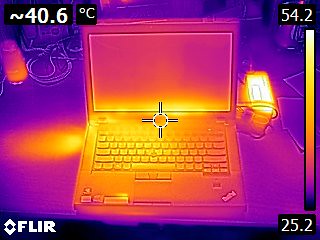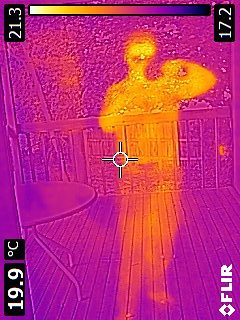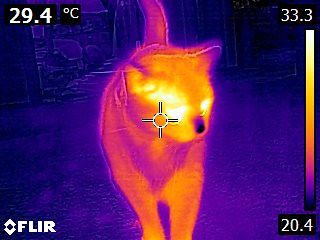Here's an Nvidia Jetson TK1 evaluation board. The round hot spot in the middle is the integrated cooling fan on top of the Tegra SoC which has four ARM Cortex-A15 cores, a fifth low-power Cortex-A15 core, and 192 GPUs. The fact that you can buy this much horsepower for only USD$192 is amazing to me. The Jetson is the next in a long (long) series of ARM-based evaluation boards that I've used to do reference ports of my company's software libraries whose code finds its way into my clients' products.

I'm an Apple user principally, and I do most of my development work on Linux or Android. But I have to keep a Windows laptop around for one technical reason or another. (I also run Windows in a VM on one of my Macs.) This is my Lenovo Thinkpad T430s that I use for field troubleshooting. What's interesting is you can really tell where the exhaust vent for the fan is by that heat signature on the left hand side. Also note the power brick on the right.

This stuff is tricky. This is my ghostly reflection in a Pella double-paned low-emissivity sliding glass door at the Palatial Overclock Estate. There is clearly a bit of an art at discriminating direct IR from reflected IR. I ordered a roll of emissivity calibration tape that is made to be used for just this purpose.

FLIRcat!

I chose the FLIR Systems E8 for a variety of reasons. My tiny company could afford it, although it was still an expensive piece of kit, even for a guy that's used to buying a new server, laptop, or evaluation board at the drop of a hat. I think the E-serie's MSX imaging technology that incorporates both an IR camera and a conventional camera makes it a lot easier to tell just what the heck you're really looking at, particularly when you are reviewing images taken perhaps days earlier. Ditto with the 320 x 240 pixel resolution, which I expect to come in handy when peering at components on a printed circuit board. And the unit is portable and easy to use so I won't hesitate to schlep it around to client sites.
I have used a relatively inexpensive IR thermometer with a laser sight for similar purposes for several years now. It will be interesting to see if the E8 replaces my IR thermometer completely or is merely an additional tool in my kit.

2 comments:
I picked up the FLIRone iPhone attached IR camera. Only $355 but the resolution is limited to 80x60. Makes similar pictures to yours. The hound has an obviously cold nose in his portraits.
I picked up the FLIRone iPhone attached IR camera. Only $355 but the resolution is limited to 80x60. Makes similar pictures to yours. The hound has an obviously cold nose in his portraits.
Post a Comment